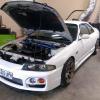R33 Rb30 Conversion
Announcements
-
Similar Content
-
Latest Posts
-
By Watermouse · Posted
Another question sorry, what stainless do u use in the turbo external WG plumb back piping? Is it 321, 316 or 304? -
Right, its been a while for updating this car, but I made some small but important progress today. In the end I bought an Ecutek dongle from the Australian distributor Tunehouse (for local hardware support) but have gone with a remote tune from Racebox in the US (because they have done millions of these, and I could not find any tuner where I could access the tune anyway as they are all password locked). The App is reasonably easy to work with, but the PC software reminds me of Haltech's ECU Manager that you need to use with the Plat Pro ECUs, it is a nightmare. Anyway, I sent the details over, got back a tune file and a request for data logs. I finally got a chance to access a private test track today as they want redline logs in 3rd and 4th, and have sent them back for the first round of reviews. The main difference in the tune is going from 1.0 (stock) to 1.3 bar (19psi), although I'm sure is a lot of other stuff in the background. Keeping in mind this is a dead stock car with 125,000klm, this is what the App's performance test claimed: Before After Interesting to note that both 400m tests had the same terminal speed (158klm/h) but different ETs. And no, the speed limiter seems to be higher than that at 186kl/h. Summary of the key logged parameters for the 3rd and 4th gear runs were: Those little turbos were certainly whizzing at 200,000rpm+. Also I'm really not that excited about oil pressure 55psi at redline so I think I'll go thicker than 5w30 (nissan recommend 0w20....) and see if that improves it. Other than that (and the big boost spike....) everything looks good as a start to me.
-
Just one more post to show the final result and the original "janky" solution for a laugh. Everything feels really tight and no wobbling at all, very pleased 🙂
-
After drying a few days, time to put her back together
-
By Watermouse · Posted
Ahh ok, thanks again for your valued insight Tao
-






Recommended Posts
Create an account or sign in to comment
You need to be a member in order to leave a comment
Create an account
Sign up for a new account in our community. It's easy!
Register a new accountSign in
Already have an account? Sign in here.
Sign In Now